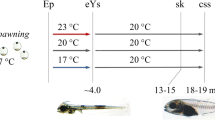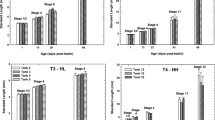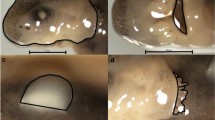Abstract
Vertical position and movement rate were measured in the yolk-sac larvae of the Pacific cod Gadus macrocephalus at different rearing temperatures (3, 5, 7, and 9 °C) and an identical temperature of 5 °C in experimental columns during the initial 3 days post-hatch (dph). Larval specific gravity was also measured through sinking velocities. Yolk-sac larvae swam upward and initially (0 dph) remained in the upper section of the experimental column through intermittent upward swimming, and gradually moved to near-neutral buoyancy at 3 dph at corresponding rearing temperatures. Rearing temperature significantly affected the swimming ability: at 0 dph, vertical movement rates measured at 5 °C were low in the yolk-sac larvae reared at warm temperatures. However, no such difference was observed at 3 dph. The difference in vertical movement rate may have resulted from the temperature-mediated body sizes (standard length) and yolk-sac sizes (yolk-sac volume) at hatching. Specific gravity did not change for the varying temperatures during the initial 3 days, but decreased as ontogeny progressed. Therefore, we suggest that Pacific cod yolk-sac larvae achieve a demersal-pelagic habitat transition through upward swimming and increasing buoyancy.





Similar content being viewed by others
References
Alderdice D, Forrester C (1971) Effects of salinity, temperature, and dissolved oxygen on early development of the Pacific cod (Gadus macrocephalus). J Fish Res Board Can 28:883–902
Laurel B, Stoner A, Ryer C, Hurst T, Abookire A (2007) Comparative habitat associations in juvenile Pacific cod and other gadids using seines, baited cameras and laboratory techniques. J Exp Mar Biol Ecol 351:42–55
Sakurai Y, Hattori T (1996) Reproductive behavior of Pacific cod in captivity. Fish Sci 62:222–228
Takatsu T, Nakatani T, Miyamoto T, Kooka K, Takahashi T (2002) Spatial distribution and feeding habits of Pacific cod (Gadus macrocephalus) larvae in Mutsu Bay, Japan. Fish Oceanogr 11:90–101
Bian X, Zhang X, Sakurai Y, Jin X, Gao T, Wan R, Yamamoto J (2014) Envelope surface ultrastructure and specific gravity of artificially fertilized Pacific cod Gadus macrocephalus eggs. J Fish Biol 84:403–421
Forrester C (1964) Laboratory observations on embryonic development and larvae of the Pacific cod (Gadus macrocephalus Tilesius). J Fish Res Board Can 21:9–16
Hurst TP, Cooper DW, Scheingross JS, Seale EM, Laurel BJ, Spencer ML (2009) Effects of ontogeny, temperature, and light on vertical movements of larval Pacific cod (Gadus macrocephalus). Fish Oceanogr 18:301–311
Sakurai Y (2007) An overview of the Oyashio ecosystem. Deep-Sea Res Pt II 54:2526–2542
Laurel BJ, Copeman LA, Hurst TP, Parrish CC (2010) The ecological significance of lipid/fatty acid synthesis in developing eggs and newly hatched larvae of Pacific cod (Gadus macrocephalus). Mar Biol 157:1713–1724
Davis MW, Olla BL (1994) Ontogenetic shift in geotaxis for walleye pollock, Theragra chalcogramma free embryos and larvae: potential role in controlling vertical distribution. Environ Biol Fishes 39:313–318
Webb PW, Weihs D (1986) Functional locomotor morphology of early life-history stages of fishes. Trans Am Fish Soc 115:115–127
Grønkjær P, Wieland K (1997) Ontogenetic and environmental effects on vertical distribution of cod larvae in the Bornholm Basin, Baltic Sea. Mar Ecol Prog Ser 154:91–105
Methven DA, Brown JA (1991) Time of hatching affects development, size, yolk volume, and mortality of newly hatched Macrozoarces americanus (Pisces: Zoarcidae). Can J Zool 69:2161–2167
Laurel BJ, Hurst TP, Copeman LA, Davis MW (2008) The role of temperature on the growth and survival of early and late hatching Pacific cod larvae (Gadus macrocephalus). J Plankton Res 30:1051–1060
Hunt von Herbing I (2002) Effects of temperature on larval fish swimming performance: the importance of physics to physiology. J Fish Biol 61:865–876
Beveridge OS, Petchey OL, Humphries S (2010) Mechanisms of temperature-dependent swimming: the importance of physics, physiology and body size in determining protist swimming speed. J Exp Biol 213:4223–4231
Pepin P (1991) Effect of temperature and size on development, mortality, and survival rates of the pelagic early life history stages of marine fish. Can J Fish Aquat Sci 48:503–518
Otterlei E, Nyhammer G, Folkvord A, Stefansson SO (1999) Temperature-and size-dependent growth of larval and early juvenile Atlantic cod (Gadus morhua): a comparative study of Norwegian coastal cod and northeast Arctic cod. Can J Fish Aquat Sci 56:2099–2111
Folkvord A (2005) Comparison of size-at-age of larval Atlantic cod (Gadus morhua) from different populations based on size-and temperature-dependent growth models. Can J Fish Aquat Sci 62:1037–1052
Litvak MK, Leggett WC (1992) Age and size-selective predation on larval fishes—the bigger-is-better hypothesis revisited. Mar Ecol Prog Ser 81:13–24
Leggett W, Deblois E (1994) Recruitment in marine fishes: is it regulated by starvation and predation in the egg and larval stages? Neth J Sea Res 32:119–134
Shepherd T, Costain K, Litvak M (2000) Effect of development rate on the swimming, escape responses, and morphology of yolk-sac stage larval American plaice, Hippoglossoides platessoides. Mar Biol 137:737–745
Saborido-Rey F, Kjesbu OS, Thorsen A (2003) Buoyancy of Atlantic cod larvae in relation to developmental stage and maternal influences. J Plankton Res 25:291–307
Yin M, Blaxter J (1987) Temperature, salinity tolerance, and buoyancy during early development and starvation of Clyde and North Sea herring, cod, and flounder larvae. J Exp Mar Biol Ecol 107:279–290
Batty R, Blaxter J (1992) The effect of temperature on the burst swimming performance of fish larvae. J Exp Biol 170:187–201
Childs MR, Clarkson RW (1996) Temperature effects on swimming performance of larval and juvenile Colorado squawfish: implications for survival and species recovery. Trans Am Fish Soc 125:940–947
Green BS, Fisher R (2004) Temperature influences swimming speed, growth and larval duration in coral reef fish larvae. J Exp Mar Biol Ecol 299:115–132
Peck MA, Buckley LJ, Bengtson DA (2006) Effects of temperature and body size on the swimming speed of larval and juvenile Atlantic cod (Gadus morhua): implications for individual-based modelling. Environ Biol Fishes 75:419–429
Døving K, Mårstøl M, Andersen J, Knutsen J (1994) Experimental evidence of chemokinesis in newly hatched cod larvae (Gadus morhua L.). Mar Biol 120:351–358
Neilson JD, Perry RI, Valerio P, Waiwood KG (1986) Condition of Atlantic cod Gadus morhua larvae after the transition to exogenous feeding—morphometrics, buoyancy and predator avoidance. Mar Ecol Prog Ser 32:229–235
Millero FJ, Poisson A (1981) International one-atmosphere equation of state of seawater. Deep-Sea Res 28:625–629
Bian X, Zhang X, Sakrai Y, Jin X, Gao T, Wan R, Yamamoto J (2014) Temperature-mediated survival, development and hatching variation of Pacific cod Gadus macrocephalus eggs. J Fish Biol 84:85–105
Hunt von Herbing I, Boutilier R, Miyake T, Hall B (1996) Effects of temperature on morphological landmarks critical to growth and survival in larval Atlantic cod (Gadus morhua). Mar Biol 124:593–606
Boehlert GW, Gadomski DM, Mundy BC (1985) Vertical distribution of ichthyoplankton off the Oregon coast in spring and summer months. Fish Bull 83:611–621
Houde E, Hoyt R (1987) Fish early life dynamics and recruitment variability. Am Fish Soc Symp 2:17–29
Acknowledgments
We thank to the Wakinosawa Fishery Association for offering great quality Pacific cod eggs. Thanks are also extended to two anonymous reviewers for detailed revision and helpful comments on this manuscript.
Author information
Authors and Affiliations
Corresponding author
Electronic supplementary material
Below is the link to the electronic supplementary material.
Rights and permissions
About this article
Cite this article
Li, Z., Yamamoto, J. & Sakurai, Y. Vertical position, specific gravity and swimming ability of Pacific cod Gadus macrocephalus yolk-sac larvae reared at four temperatures. Fish Sci 81, 883–889 (2015). https://doi.org/10.1007/s12562-015-0911-6
Received:
Accepted:
Published:
Issue Date:
DOI: https://doi.org/10.1007/s12562-015-0911-6




